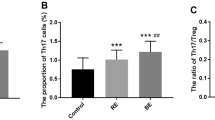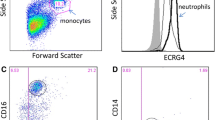Abstract
Aims
C1q, an element of the first component of complement, is known to be expressed by interdigitating and follicular dendritic cells in the spleen, where it has been suggested that C1q is involved in capturing immune complexes. The present study investigated whether C1q is expressed in Barrett's esophagus and esophageal adenocarcinoma and, if so, whether its expression is associated with dendritic cells.
Material and Methods
Endoscopic biopsy or operative surgical specimens were obtained from 15 patients with Barrett's esophagus, 13 patients with esophageal adenocarcinoma and 12 patients whose biopsy specimens did not show the presence of specialized intestinal metaplasia or adenocarcinoma. Barrett's esophagus was diagnosed by the presence of a macroscopic area of columnar-lined esophagus as well as microscopic intestinal metaplasia with goblet cells. Immunohistochemistry utilizing anti-C1q and markers for dendritic cells and macrophages was performed on sections of tissue samples embedded in paraffin. Double immunostaining with C1q/CD83 and C1q/CD68 was used to analyze the possible co-localization of C1q with dendritic cells and macrophages. The expression of C1q by dendritic cells and macrophages was also examined in in vitro studies using reverse transcriptase polymerase chain reaction (RT-PCR) and Western blotting.
Results
In all specimens studied, C1q expression was detected as being distributed irregularly throughout the lamina propria. A computerized quantitative analysis showed that C1q expression was significantly higher in tissue specimens without specialized intestinal-type metaplasia than in Barrett's esophagus specimens and specimens with adenocarcinoma. Double immunostaining revealed that dendritic cells and macrophages expressed C1q in all analyzed esophageal specimens. The expression of C1q by dendritic cells and macrophages was also demonstrated in in vitro studies using RT-PCR and Western blotting.
Conclusion
The findings suggest that reduced levels of the expression of C1q by dendritic cells and macrophages in the esophagus may play a role in the formation of immune responses associated with the formation of specialized intestinal metaplasia and the development of adenocarcinoma.




Similar content being viewed by others
References
O'Byrne KJ, Dalgleish AG. Chronic immune activation and inflammation as the cause of malignancy. Br J Cancer 2001;85:473–483.
Macarthur M, Hold GL, El-Omar EM. Inflammation and Cancer II. Role of chronic inflammation and cytokine gene polymorphisms in the pathogenesis of gastrointestinal malignancy. Am J Physiol Gastrointest Liver Physiol 2004;286:G515–520.
Mantovani A, Allavena P, Sica A, et al. Cancer-related inflammation. Nature 2008;454:436–444.
Oberg S, Peters JH, DeMeester TR, et al. Inflammation and specialized intestinal metaplasia of cardiac mucosa is a manifestation of gastroesophageal reflux disease. Ann Surg 1997;226:522–530.
Der R, Tsao-Wei DD, DeMeester T, et al. Carditis: a manifestation of gastroesophageal reflux disease. Am J Surg Pathol 2001;25:245–252.
Moons LM, Kusters JG, Bultman E, et al. Barrett's oesophagus is characterized by a predominantly humoral inflammatory response. J Pathol 2005;207:269-276.
Abdel-Latif MM, Duggan S, Reynolds JV et al. Inflammation and esophageal carcinogenesis. Curr Opin Pharmacol 2009;9:396–404.
Bobryshev YV, Tran D, Killingsworth MC et al. Dendritic cells in Barrett's esophagus and esophageal adenocarcinoma. J Gastrointest Surg 2009;13:44–53.
Banchereau J, Briere F, Caux C, Davoust J, Lebecque S, Liu YJ, Pulendran B, Palucka K. Immunobiology of dendritic cells. Annu Rev Immunol 2000;18:767–811.
Steinman RM, Banchereau J. Taking dendritic cells into medicine. Nature 2007;449;419–426.
van de Ven R, Scheffer GL, Scheper RJ, et al. The ABC of dendritic cell development and function. Trends Immunol 2009;30:421–429.
Lotze MT, Thomson AW, eds. Dendritic cells: Biology and Clinical Applications, 2nd edn. San Diego, CA: Academic Press, 2001.
Lipscomb MF, Masten BJ. Dendritic cells: immune regulators in health and disease. Physiol Rev 2002;82;97–130.
van Kooten C, Fiore N, Trouw LA, Csomor E, Xu W, Castellano G, Daha MR, Gelderman KA. Complement production and regulation by dendritic cells: molecular switches between tolerance and immunity. Mol Immunol 2008;45:4064–4072.
Lu J, Wu X, Teh BK. The regulatory roles of C1q. Immunobiology 2007;212:245–252.
Lu JH, Teh BK, Wang L, Wang YN, Tan YS, Lai MC, Reid KB. The classical and regulatory functions of C1q in immunity and autoimmunity. Cell Mol Immunol 2008;5:9–21.
Schwaeble W, Schafer M.K, Petry F, et al. Follicular dendritic cells, interdigitating cells, and cells of the monocyte-macrophage lineage are the C1q-producing sources in the spleen. Identification of specific cell types by in situ hybridization and immunohistochemical analysis. J Immunol 1995;155:4971–4978.
Cook HT, Botto M. Mechanisms of Disease: the complement system and the pathogenesis of systemic lupus erythematosus. Nat Clin Pract Rheumatol 2006;2:330–337.
Truedsson L, Bengtsson AA, Sturfelt G. Complement deficiencies and systemic lupus erythematosus. Autoimmunity 2007;40:560–566.
Lindau D, Decker P. Nph, DC and chromatin-mediated pathogenesis in systemic lupus erythematosus. Autoimmunity 2009;42:254–256.
Lechmann M, Zinser E, Golka A, Steinkasserer A. Role of CD83 in the immunomodulation of dendritic cells. Int Arch Allergy Immunol 2002;129:113–118.
Engering A, Geijtenbeek TB, van Vliet SJ, et al.The dendritic cell-specific adhesion receptor DC-SIGN internalizes antigen for presentation to T cells. J Immunol 2002;168:2118–2126.
Cao W, Lee SH, Lu J. CD83 is preformed inside monocytes, macrophages and dendritic cells, but it is only stably expressed on activated dendritic cells. Biochem J 2005;385(Pt 1):85–93.
Bobryshev YV, Cao W, Phoon MC, Tran D, Chow VT, Lord RS, Lu J. Detection of Chlamydophila pneumoniae in dendritic cells in atherosclerotic lesions. Atherosclerosis 2004;173:185–195.
Lu J, Zheng MH, Yan J, Chen YP, Pan JP. Effects of vasoactive intestinal peptide on phenotypic and functional maturation of dendritic cells. Int Immunopharmacol. 2008;8:1449–1454.
Kishore U, Reid K.B. C1q: structure, function, and receptors. Immunopharmacology 2000, 49:159–170.
Reid K.B, Colomb M, Petry F, Loos M. Complement component C1 and the collectins—first-line defense molecules in innate and acquired immunity. Trends Immunol 2002;23:115–117.
Botto M, Dell'Agnola C, Bygrave AE, Thompson EM, Cook HT, Petry F, Loos M, Pandolfi PP, Walport MJ. Homozygous C1q deficiency causes glomerulonephritis associated with multiple apoptotic bodies. Nat Genet 1998;19:56–569.
Botto M. C1q knock-out mice for the study of complement deficiency in autoimmune disease. Exp Clin Immunogenet 1998;15:231–234.
Schaller M, Bigler C, Danner D, Ditzel HJ, Trendelenburg M. Autoantibodies against C1q in systemic lupus erythematosus are antigen-driven. J Immunol 2009;183:8225–8231.
Kaisho T. Type I interferon production by nucleic acid-stimulated dendritic cells. Front Biosci 2008;13:6034-6042.
Finke D, Eloranta ML, Rönnblom L. Endogenous type I interferon inducers in autoimmune diseases. Autoimmunity 2009;42:349–352.
Acknowledgements
We thank the Cancer Institute of New South Wales and the St. Vincent's Clinic Foundation, Sydney, for financial support. We thank Dr. Dinh Tran for assistance with immunohistochemical staining.
Author information
Authors and Affiliations
Corresponding author
Rights and permissions
About this article
Cite this article
Bobryshev, Y.V., Lu, J. & Lord, R.V.N. Expression of C1q Complement Component in Barrett’s Esophagus and Esophageal Adenocarcinoma. J Gastrointest Surg 14, 1207–1213 (2010). https://doi.org/10.1007/s11605-010-1230-y
Received:
Accepted:
Published:
Issue Date:
DOI: https://doi.org/10.1007/s11605-010-1230-y




